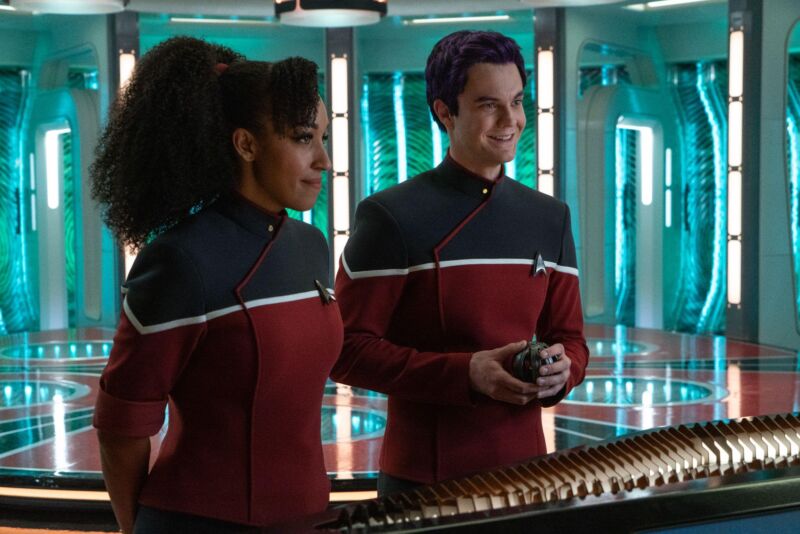
Enlarge / Tawny Newsome (left) and Jack Quaid reprising their roles as Beckett Mariner and Brad Boimler… but in real life this time.
Paramount
The second season of Star Trek: Strange New Worlds, much like the first one, has been fun at least partly because the show itself is not all that new or strange.
The characters and visuals and specific plot constructs are new, but at its heart the show is a painstaking reconstruction of The Next Generation formula from Star Trek’s 90s-era creative and commercial peak: ensemble cast, primarily episodic storytelling with lightly serialized character development and recurring arcs, and a willingness to mix high-concept sci-fi with just the right amount of silliness. It’s also very good at taking old Star Trek tropes—the transporter accident, the disease-on-the-ship, the talky courtroom thriller about the nature of humanity—and making them feel fresh again.
Episode 7, which went up early this weekend to coincide with a Comic-Con screening, exhumes and expertly executes yet another shopworn trope, something we haven’t seen on Star Trek since the days when Quark might show up on the viewscreen of the Enterprise-D: the crossover episode. And despite the wide gap between Strange New Worlds and the animated Lower Decks, the blending of the two shows’ disparate styles comes together better than any gimmicky attempt at cross-promotion has any right to.
What is this, a crossover episode?
Let me be clear about what I mean when I talk about “crossover episodes.” By its strictest definition, a “crossover episode” occurs any time any fictional character from one show turns up on another show. But there are nuances.
The Marvel Cinematic Universe (and the general MCU-ification of wide swaths of the television landscape) means that broadly defined “crossover episodes” happen all the time, and you are expected to watch totally separate shows that suck but take place in the same fictional universe to keep up with crucial plot developments on shows you want to watch. That’s not quite the type of crossover episode I want to discuss, though. Nor am I talking about the times when a character on one show shows up on another related spinoff show (either temporarily or permanently) after the original show is canceled, like when Worf jumped over to Deep Space 9, or when Spike moved from Buffy the Vampire Slayer to Angel, or when characters from Cheers occasionally popped up on Frasier.
The specific kind of crossover episode that Strange New Worlds is executing is an intentionally gimmicky one-time thing that happens between two established but separate shows, often advertised heavily in the hopes of encouraging cross-pollination between two shows’ fanbases. They often require bending of one or both shows’ reality to work—to the point that they occasionally create paradoxes where one actor plays different characters that exist in the same reality, or where Tony Soprano watches a show where people talk about the TV character Tony Soprano, or where characters from one show exist in another show both as fictional TV characters and as real people. I’m talking about The Jetsons Meet The Flintstones, I’m talking about characters from Mad About You showing up on Friends, I’m talking about Stewie from Family Guy talking to David Boreanaz on Bones. That it feels silly and a little forced is part of the fun.
>>> Read full article>>>
Copyright for syndicated content belongs to the linked Source : Ars Technica – https://arstechnica.com/?p=1955274































